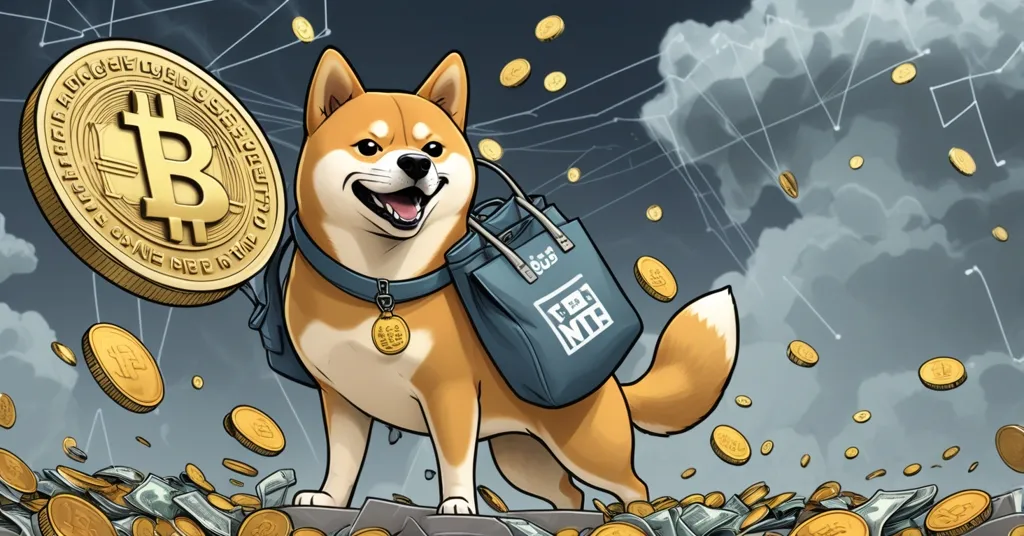Dogecoin Whale Dumps 132M DOGE on Robinhood as Price Crashes Below $0.2

Dogecoin Under Fire: Whale Moves 132 Million DOGE to Robinhood Amid Price Collapse
Picture this: a staggering 132 million Dogecoin (DOGE), worth about $27 million, gets shifted to Robinhood, a platform synonymous with retail trading, just as the meme coin’s price tanks below $0.2. Is this a signal of an impending sell-off, or just another twist in the wild ride of crypto? With the broader market reeling from U.S.-China trade tensions, Dogecoin investors are on edge, and the latest whale activity isn’t helping.
- Huge Transfer: 132 million DOGE ($27 million) deposited to Robinhood, fueling sell-off fears.
- Price Plummet: DOGE trades at $0.1882, down 4% in 24 hours, after a flash crash to $0.11.
- Market Turmoil: Crypto slump tied to Trump’s 100% tariff on China, shaking risk assets like DOGE.
Whale Transfer: Sell-Off or Simple Shuffle?
The crypto space is buzzing after Whale Alert, a service tracking large cryptocurrency transactions, flagged a transfer of 132 million DOGE to Robinhood. For the uninitiated, a “whale” is a major holder—someone or something with enough tokens to sway market sentiment with a single move. When such a hefty amount lands on an exchange like Robinhood, it often suggests the whale is gearing up to sell, either for fiat (traditional currency) or to swap for other digital assets. At $27 million, this transfer is no small potatoes, and with DOGE already struggling, the optics are grim. According to CoinMarketCap, Dogecoin is currently trading at $0.1882, down over 4% in the last 24 hours, having even nosedived to $0.11 in a recent flash crash. That’s a gut punch for investors clinging to the $0.2 level as a psychological safety net. For more on this massive movement, check out the latest report on the Dogecoin whale transfer.
Before we sound the panic alarm, let’s peel back the layers. On-chain data—information pulled directly from the blockchain—hints that this might not be a straight-up sell-off. There’s a decent chance this is an internal shuffle within Robinhood’s own wallets. Exchanges often move funds between “hot wallets” (online storage for quick transactions, like a digital cash register) and “cold wallets” (offline, secure storage akin to a bank vault) for operational or security reasons. If that’s the case here, there’s no immediate selling pressure from this particular transaction. Still, the lack of transparency in these movements is a stark reminder of how opaque crypto markets can be. Unlike traditional finance, where regulatory oversight often forces clarity, crypto operates in a gray zone where a single misunderstood transfer can spark widespread fear, uncertainty, and doubt (FUD). For Dogecoin holders, this ambiguity is just salt in the wound during an already rough patch.
Market Meltdown: The Trade War Fallout
While this whale transfer has grabbed headlines, it’s only part of a larger storm battering the crypto space. The broader market downturn aligns with escalating U.S.-China trade tensions, sparked by President Trump’s announcement of a 100% tariff on Chinese goods, set to take effect next month. Tariffs like these jack up the cost of imported goods, spooking investors who fear a domino effect of economic slowdowns. Cryptocurrencies, especially speculative ones like Dogecoin, are often treated as “risk assets”—high-reward investments that get dumped first when uncertainty looms, much like volatile stocks. Bitcoin might weather such storms better due to its narrative as digital gold, but meme coins? They’re the wildcards that bleed fastest when panic sets in.
Zooming into Dogecoin’s on-chain metrics via Santiment, a crypto analytics platform, the picture gets uglier. Whale transactions—large trades by big players—are drying up, signaling that these heavy hitters aren’t swooping in to buy the dip, a move often seen as a bullish reversal sign. Transaction volume, which measures the total value of DOGE changing hands on the blockchain (think of it as gauging how busy a marketplace is), has also cratered. Mid-October saw volume drop from a peak of $4 billion to a measly $214 million in just days. That’s a glaring red flag of waning interest or activity. Worse, DOGE’s price breaching $0.2—a key “support level” where buyers historically step in to halt further drops, like a safety net—has shattered confidence among retail traders, many of whom are likely staring at red portfolios right now.
Bullish Hopes or Hopium? Analyst Predictions for DOGE
Amidst the bearish bloodbath, some analysts are waving the optimism flag, though I’ll warn you upfront: take these with a hefty grain of salt. Crypto analyst Javon Marks posted on X with a forecast that’s bold, if not outright bonkers.
“DOGE is getting ready for its next cyclical surge to a new ATH and beyond, as it did during the 2017 cycle… a minimum increase of 251% is in sight.”
Marks is banking on Dogecoin repeating past hype-driven booms, like those in 2017 and 2021, often fueled by social media buzz and endorsements from figures like Elon Musk. He’s even floating a price target of $4 by next year—a mind-boggling leap from today’s sub-$0.20 reality. For context, an “all-time high” (ATH) is the highest price a coin has ever reached, and DOGE’s current ATH sits at $0.7316 from May 2021. A 251% surge or a climb to $4 isn’t grounded in fundamentals; it’s pure speculation based on historical “cycles” of mania. Let’s be real—predicting such gains is like betting on a lottery ticket because you’ve got a “good feeling.” It might happen if the stars align and Musk tweets a Shiba Inu gif at the right moment, but it’s a long shot in today’s choppy waters.
A more measured take comes from analyst Ali Martinez, who focuses on near-term technicals.
“[DOGE] needs to stay above $0.19 to avoid a larger pullback… a hold above this level could send the meme coin to $0.33.”
Martinez is pointing to a critical support level at $0.19. In simple terms, support levels are price points where enough buyers tend to jump in to stop a freefall. If DOGE holds above this, momentum could swing toward $0.33—a decent 75% pop from current levels. It’s a less outlandish prediction, but still hinges on market sentiment flipping positive, which isn’t a given with tariffs and geopolitical noise looming.
Dogecoin’s DNA: Hype Over Substance
Let’s take a hard look at what Dogecoin really is. Launched in 2013 as a literal joke poking fun at crypto’s absurdity, DOGE has morphed into a cultural juggernaut, driven by memes, community fervor, and the occasional celebrity nod. Unlike Bitcoin, which stands as a decentralized alternative to fiat with a fixed supply and a mission of financial sovereignty, or Ethereum, which underpins a vast ecosystem of apps and smart contracts, Dogecoin’s value is almost entirely tied to sentiment. It’s the quintessential meme coin—a speculative bet that thrives on hype but crashes hard when the party ends. Historically, its pumps—like the 2021 surge where it skyrocketed over 20,000% at one point—have been tied to external triggers, not intrinsic worth. And the dumps? Brutal. Retail investors often bear the brunt, with many left holding bags after late entries.
Compare this to other meme coins like Shiba Inu (SHIB), which at least attempts branding around decentralized finance (DeFi) ecosystems, however flimsy. DOGE doesn’t even pretend to have utility beyond viral laughs. Its biggest strength—and weakness—is its accessibility to newbies. It’s often a gateway to crypto for the curious, embodying the rebellious, anti-establishment spirit we champion. But the dark side is undeniable: meme coins are a hotbed for manipulation, pump-and-dumps, and outright scams. Fake whale transfer news or coordinated hype can lure in naive investors, only for big players to cash out at their expense. If you’re dabbling in DOGE, tools like Whale Alert are your friend—verify transactions yourself and don’t fall for Twitter shills promising the moon.
Counterpoints: Why DOGE Still Has Fans
Despite the skepticism, it’s worth noting why Dogecoin retains a loyal following. Its community is fiercely dedicated, often rallying around the coin as a middle finger to traditional finance—a ethos we can get behind. Potential catalysts for a rebound do exist. Elon Musk, a longtime DOGE cheerleader, has single-handedly moved markets with tweets in the past. If he or another influencer sparks a frenzy, we could see a short-term spike, fundamentals be damned. Additionally, DOGE’s low price per token (under a dollar) gives it a psychological edge for retail buyers who feel they’re “getting more” compared to pricier coins like Bitcoin. But let’s not kid ourselves—these are fleeting drivers, not sustainable value. The risk of rug pulls or sudden dumps by major holders remains sky-high.
Bitcoin vs. Meme Coins: A Tale of Two Cryptos
As Bitcoin maximalists at heart, we can’t help but contrast DOGE’s volatility with BTC’s long-game proposition. Bitcoin is sound money—a decentralized store of value designed to outlast fiat’s inflation and government overreach. Its price swings are real, but they’re often tied to adoption milestones or macroeconomic shifts, not fleeting memes. Dogecoin and its ilk, while fun and occasionally profitable for the lucky, lack this bedrock. They’re the carnival rides of crypto—thrilling until they’re not. That said, meme coins play a niche role in onboarding newcomers, drawing attention to the broader space. Many a crypto OG started with a DOGE gamble before grasping Bitcoin’s deeper promise. So while we root for disruption, we also urge caution: don’t let a meme coin be your hill to die on.
The Bigger Picture: Crypto in a Global Storm
Stepping back, the Dogecoin drama underscores how intertwined crypto has become with global events. The U.S.-China trade war isn’t just a headline—it’s a pressure cooker for risk assets. Historically, tariffs and economic friction push investors toward safe havens, and while Bitcoin sometimes gets that “digital gold” treatment, speculative tokens like DOGE rarely do. Stablecoins, pegged to fiat like the U.S. dollar, often see inflows during such uncertainty, while meme coins bleed out. This isn’t just a DOGE problem; it’s a reminder that crypto doesn’t operate in a vacuum. For every decentralization win, there’s a geopolitical curveball waiting to smack sentiment.
Then there’s the issue of market opacity. Whether this 132 million DOGE transfer is a sell-off or a shuffle, the fact that we’re guessing speaks volumes. Exchanges like Robinhood aren’t obligated to disclose their wallet movements, leaving retail traders to speculate based on incomplete data. This lack of clarity fuels volatility and mistrust—issues Bitcoin aims to solve through transparency on the blockchain, though even BTC isn’t immune to exchange shenanigans. For Dogecoin, with its outsized retail base, these murky waters are especially treacherous.
Key Takeaways and Questions for Dogecoin Investors
- What’s driving the Dogecoin price crash in 2023?
A broader crypto market downturn, intensified by U.S.-China trade tensions following Trump’s announcement of a 100% tariff on Chinese goods, is hammering risk assets like DOGE. - Does the 132 million DOGE transfer to Robinhood mean a sell-off?
Not definitively—it could be an internal move between Robinhood’s hot and cold wallets, but the uncertainty itself stokes bearish fears among investors. - What are the warning signs for DOGE right now?
Declining whale transactions, a transaction volume collapse from $4 billion to $214 million in mid-October, and the price dropping below the crucial $0.2 support level all point to trouble. - Could Dogecoin recover in the short or long term?
Some analysts see hope—Ali Martinez predicts a rally to $0.33 if DOGE holds above $0.19, while Javon Marks speculates a 251% surge to new highs, possibly $4, though such targets rely on hype over substance. - How do geopolitical tensions impact meme coins like DOGE?
Events like trade wars create market uncertainty, prompting sell-offs in speculative assets like Dogecoin, which lack the fundamentals to endure economic shocks compared to Bitcoin or stablecoins. - What risks should retail investors watch for with Dogecoin?
Meme coins are prone to manipulation, pump-and-dumps, and sudden crashes—retail traders often lose out when major holders exit, and fake news or hype can amplify losses.
As advocates for decentralization and financial freedom, we see the chaotic charm of Dogecoin as part of crypto’s broader rebellion against the status quo. But let’s not sugarcoat it: this is a high-stakes gamble, not a savings account. The whale transfer, market slump, and speculative predictions paint a messy picture for DOGE. If you’re in the game, watch that $0.19 support like a hawk—below it, the ride gets bumpier. For everyone else, remember that while meme coins can spark interest in crypto, true disruption lies in projects with staying power. Is Dogecoin a symbol of wild innovation or a ticking time bomb for the unwary? That’s the million-dollar—or $27 million—question.



